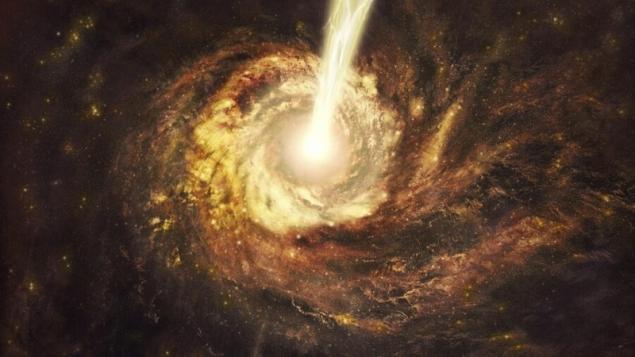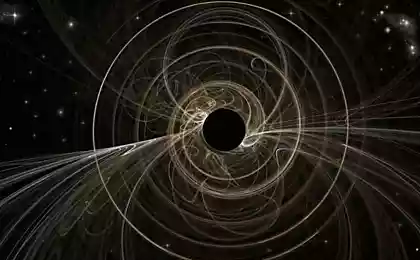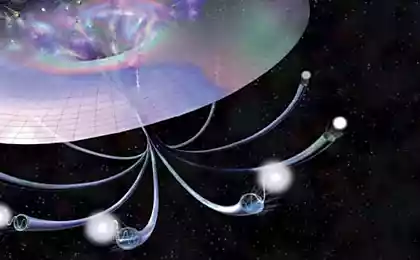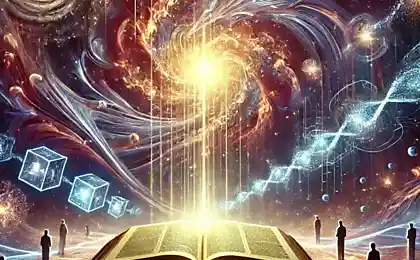514
And if the universal laws of physics?
As far as is known to physicists, space is playing by the same set of rules since the Big Bang. But could these laws to be different in the past, can they change in the future? If in some remote corner of the cosmos to dominate other laws of physics?
"This is not such an incredible opportunity," says Sean Carroll, a theoretical physicist from the California Institute of technology, who notes that when we ask the question of whether to change the laws of physics, in fact, we mean two separate questions: first, are the equations of quantum mechanics and gravity over time and space; and second, are numeric constants that inhabit these equations.

To see the difference, imagine the entire Universe as one big game of basketball. You can configure some parameters without changing the game: to raise the Hoop a little higher to make the site a little more, change the victory conditions and the game is still basketball. But if you tell the players to kick the ball with their feet, it will be a completely different game.
Most modern studies of the variability of the physical laws focused on numeric constants. Why? It's very simple. Physics can make confident, verifiable predictions about how a change in the numeric constants will affect the results of their experiments. In addition, Carroll says, physics will not turn over, if it turns out that these constants change with time. In fact, some constants have changed: the mass of the electron, for example, was zero, while the Higgs field is not turned through a fraction of a second after the Big Bang. "We have a lot of theories that can accommodate changing constants, says Carroll. — All you need to account for time-dependent constants is to add a scalar field to the theory, which moves very slowly."
Scalar field, says Carroll, is any value that has a unique value at each point of space-time. Known scalar field is the Higgs, but may be considered less exotic values, like temperature, in the form of the scalar field. Not yet open a scalar field that changes very slowly, it may continue to evolve after billions of years after the Big Bang — and with it, can evolve and so-called constants of nature.
Fortunately, the cosmos has given us a convenient Windows through which we can observe the constants as they were in the past. One of such Windows is located in the rich uranium deposits of Oklo region in Gabon, Central Africa, where in 1972 the workers serendipitously discovered a group of "natural nuclear reactors" — rocks that spontaneously ignited and supported a nuclear reaction for hundreds of thousands of years. The result: "Radioactive fossils of what looked like the laws of nature" two billion years ago, says Carroll. (For comparison, Earth is about 4 billion years and the Universe about 14 billion).
The characteristics of these minerals depend on the particular value called the fine structure constant, which merges with a handful of other constants — the speed of light, charge of an electron, the electric constant and Planck's constant is one number that is approximately 1/137. Physicists call it a "dimensionless" constant, that is, it is just a number: not 1/137 inches, seconds, or coulombs, but just 1/137. This makes it an ideal place to look for changes related permanent, said Steve Lamoreaux, a physicist from Yale University. "If the constant has changed in such a way that would change the mass of the electron and the energy of the electrostatic interaction, this would be reflected on 1/137, regardless of the measurement system".
And yet, to interpret these fossils is not easy, and for many years, scientists studying Oklo, came to contradictory conclusions. Research conducted for decades, Oklo has shown that the fine structure constant was absolutely stable. Then there was the study showing that it has become more, and then another one that claimed she became less. In 2006, Lamoreaux (then an employee of Los Alamos national laboratory) and his colleagues published a recent analysis that was, as they wrote, "sustained without improvements". However, the "dependent model" — that is, they had to make a number of assumptions about how it could change the fine structure constant.
Using atomic clocks, physicists can look for the tiniest changes in the fine structure constant, but is limited to modern variations that occur during the year or so. Scientists from the National Institute of standards and technology in boulder, Colorado, compared the time counted by atomic clocks operating on aluminum and mercury to put extremely strict limits on the daily changes of the fine structure constant. Although they are unable to say with certainty that the fine structure constant is not changing, if it changes, the variations are tiny: one kvadrilliona percent each year.
Today, the best limits on how can to change the constant during the life of the Universe, derived from observations of remote objects in the sky. That is because the further into space you look, the further back in time you will be able to look. "The time machine" stopped Oklo two billion years ago, but using the light of distant quasars, the astronomers moved the space time machine 11 billion years ago.
Quasars — extremely bright ancient objects that astronomers believe luminous supermassive black holes. As the light from this quasar is moving towards us, some of it is absorbed by the gas through which it passes on the way. But is absorbed unevenly removed only specific wavelengths, or colors. Specific colors "deleted" from the spectrum, depend on how photons of light of a quasar interacting with gas atoms, and these interactions depend on the fine structure constant. So, looking at the light spectrum of distant quasars, astrophysicists can look for changes of the fine structure constant for many billions of years.
"By the time that light reaches us here on Earth, he will gather information about the number of galaxies billions of years ago, says Tyler Evans, lead researcher of quasars at Swinburne University of Technology in Australia. — This is similar to the slice of eternal ice on the Ground to find out what was the climate of previous eras".Despite some tantalizing hints, recent studies show that changes in the fine structure constant "match the scratch". This does not mean that the fine structure constant does not change. But if you change, it does it more subtly than can catch our experiments, and this is unlikely, says Carroll. "It's hard to cram theory into something between not changing and changing so that we don't notice".
Astrophysics also looking for a change G, the gravitational constant, which is related to the force of gravity. In 1937, Paul Dirac, one of the pioneers of quantum mechanics, suggested that gravity becomes weaker as the aging of the Universe. Although this idea is not confirmed, physicists continue to look for changes in the gravitational constant, and today a variety of exotic alternative theories of gravity include a shift of the gravitational constant. Although laboratory experiments on Earth returned confusing results, studies out have shown that G is not really changing, if change at all. Not so long ago, radio astronomers celebrated 21 years of collecting accurate data on the timing of an unusually bright and stable pulsar, with the aim of finding changes in its regular "heartbeat" in the form of signals indicating the change of the gravitational constant. The result: nothing.
But back to the second, tougher half of our original question: can the laws of physics, not only permanent, sewn into them to change? "To this question the answer is much more complicated, says Carroll, marking also that you should bear in mind the different degree of change. If the laws of a number of pottery of quantum mechanics, like quantum electrodynamics, will be malleable, perhaps existing theories can cope with it. But if you find yourself changing laws of quantum mechanics, says Carroll, "it will be very strange." No theory does not suggest how or why can such a change happen; there is simply no framework within which to study this question.
Based on all that we have, we can say that the universe is fair game. But physics would clarify the rulebook, looking for clues that may indicate a change in the rules of the game at the level that we have not yet perceived. published
Author: Ilya Hel
P. S. And remember, only by changing their consumption — together we change the world! ©
Join us in Facebook , Vkontakte, Odnoklassniki
Source: hi-news.ru/space/a-tak-li-universalny-zakony-fiziki.html
"This is not such an incredible opportunity," says Sean Carroll, a theoretical physicist from the California Institute of technology, who notes that when we ask the question of whether to change the laws of physics, in fact, we mean two separate questions: first, are the equations of quantum mechanics and gravity over time and space; and second, are numeric constants that inhabit these equations.

To see the difference, imagine the entire Universe as one big game of basketball. You can configure some parameters without changing the game: to raise the Hoop a little higher to make the site a little more, change the victory conditions and the game is still basketball. But if you tell the players to kick the ball with their feet, it will be a completely different game.
Most modern studies of the variability of the physical laws focused on numeric constants. Why? It's very simple. Physics can make confident, verifiable predictions about how a change in the numeric constants will affect the results of their experiments. In addition, Carroll says, physics will not turn over, if it turns out that these constants change with time. In fact, some constants have changed: the mass of the electron, for example, was zero, while the Higgs field is not turned through a fraction of a second after the Big Bang. "We have a lot of theories that can accommodate changing constants, says Carroll. — All you need to account for time-dependent constants is to add a scalar field to the theory, which moves very slowly."
Scalar field, says Carroll, is any value that has a unique value at each point of space-time. Known scalar field is the Higgs, but may be considered less exotic values, like temperature, in the form of the scalar field. Not yet open a scalar field that changes very slowly, it may continue to evolve after billions of years after the Big Bang — and with it, can evolve and so-called constants of nature.
Fortunately, the cosmos has given us a convenient Windows through which we can observe the constants as they were in the past. One of such Windows is located in the rich uranium deposits of Oklo region in Gabon, Central Africa, where in 1972 the workers serendipitously discovered a group of "natural nuclear reactors" — rocks that spontaneously ignited and supported a nuclear reaction for hundreds of thousands of years. The result: "Radioactive fossils of what looked like the laws of nature" two billion years ago, says Carroll. (For comparison, Earth is about 4 billion years and the Universe about 14 billion).
The characteristics of these minerals depend on the particular value called the fine structure constant, which merges with a handful of other constants — the speed of light, charge of an electron, the electric constant and Planck's constant is one number that is approximately 1/137. Physicists call it a "dimensionless" constant, that is, it is just a number: not 1/137 inches, seconds, or coulombs, but just 1/137. This makes it an ideal place to look for changes related permanent, said Steve Lamoreaux, a physicist from Yale University. "If the constant has changed in such a way that would change the mass of the electron and the energy of the electrostatic interaction, this would be reflected on 1/137, regardless of the measurement system".
And yet, to interpret these fossils is not easy, and for many years, scientists studying Oklo, came to contradictory conclusions. Research conducted for decades, Oklo has shown that the fine structure constant was absolutely stable. Then there was the study showing that it has become more, and then another one that claimed she became less. In 2006, Lamoreaux (then an employee of Los Alamos national laboratory) and his colleagues published a recent analysis that was, as they wrote, "sustained without improvements". However, the "dependent model" — that is, they had to make a number of assumptions about how it could change the fine structure constant.
Using atomic clocks, physicists can look for the tiniest changes in the fine structure constant, but is limited to modern variations that occur during the year or so. Scientists from the National Institute of standards and technology in boulder, Colorado, compared the time counted by atomic clocks operating on aluminum and mercury to put extremely strict limits on the daily changes of the fine structure constant. Although they are unable to say with certainty that the fine structure constant is not changing, if it changes, the variations are tiny: one kvadrilliona percent each year.
Today, the best limits on how can to change the constant during the life of the Universe, derived from observations of remote objects in the sky. That is because the further into space you look, the further back in time you will be able to look. "The time machine" stopped Oklo two billion years ago, but using the light of distant quasars, the astronomers moved the space time machine 11 billion years ago.
Quasars — extremely bright ancient objects that astronomers believe luminous supermassive black holes. As the light from this quasar is moving towards us, some of it is absorbed by the gas through which it passes on the way. But is absorbed unevenly removed only specific wavelengths, or colors. Specific colors "deleted" from the spectrum, depend on how photons of light of a quasar interacting with gas atoms, and these interactions depend on the fine structure constant. So, looking at the light spectrum of distant quasars, astrophysicists can look for changes of the fine structure constant for many billions of years.
"By the time that light reaches us here on Earth, he will gather information about the number of galaxies billions of years ago, says Tyler Evans, lead researcher of quasars at Swinburne University of Technology in Australia. — This is similar to the slice of eternal ice on the Ground to find out what was the climate of previous eras".Despite some tantalizing hints, recent studies show that changes in the fine structure constant "match the scratch". This does not mean that the fine structure constant does not change. But if you change, it does it more subtly than can catch our experiments, and this is unlikely, says Carroll. "It's hard to cram theory into something between not changing and changing so that we don't notice".
Astrophysics also looking for a change G, the gravitational constant, which is related to the force of gravity. In 1937, Paul Dirac, one of the pioneers of quantum mechanics, suggested that gravity becomes weaker as the aging of the Universe. Although this idea is not confirmed, physicists continue to look for changes in the gravitational constant, and today a variety of exotic alternative theories of gravity include a shift of the gravitational constant. Although laboratory experiments on Earth returned confusing results, studies out have shown that G is not really changing, if change at all. Not so long ago, radio astronomers celebrated 21 years of collecting accurate data on the timing of an unusually bright and stable pulsar, with the aim of finding changes in its regular "heartbeat" in the form of signals indicating the change of the gravitational constant. The result: nothing.
But back to the second, tougher half of our original question: can the laws of physics, not only permanent, sewn into them to change? "To this question the answer is much more complicated, says Carroll, marking also that you should bear in mind the different degree of change. If the laws of a number of pottery of quantum mechanics, like quantum electrodynamics, will be malleable, perhaps existing theories can cope with it. But if you find yourself changing laws of quantum mechanics, says Carroll, "it will be very strange." No theory does not suggest how or why can such a change happen; there is simply no framework within which to study this question.
Based on all that we have, we can say that the universe is fair game. But physics would clarify the rulebook, looking for clues that may indicate a change in the rules of the game at the level that we have not yet perceived. published
Author: Ilya Hel
P. S. And remember, only by changing their consumption — together we change the world! ©
Join us in Facebook , Vkontakte, Odnoklassniki
Source: hi-news.ru/space/a-tak-li-universalny-zakony-fiziki.html
Ever since humanity switched to margarine and yeast, common sense no longer works.
How to cook cream for Mature skin: 11 tested recipes























